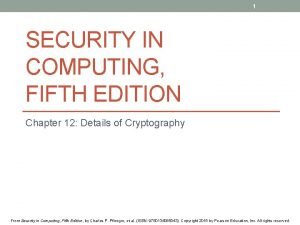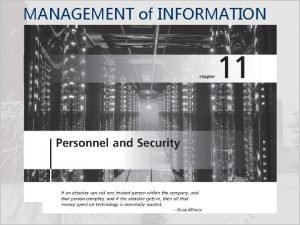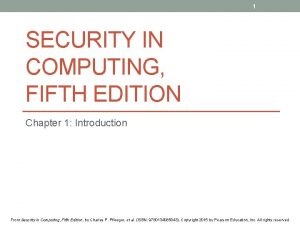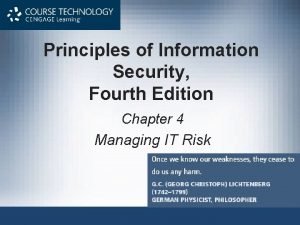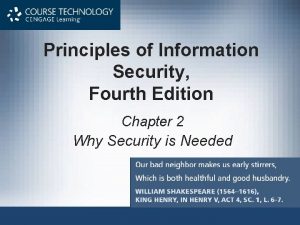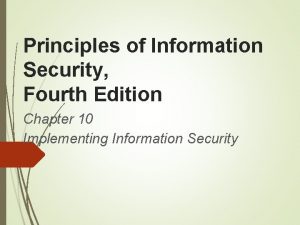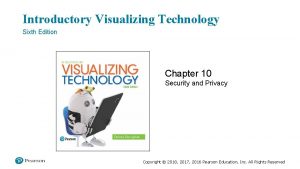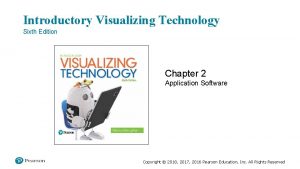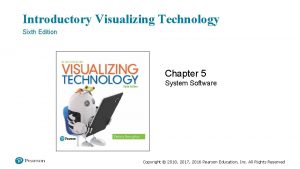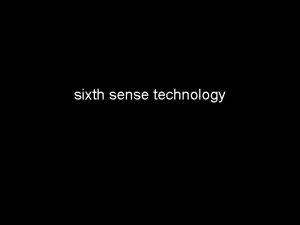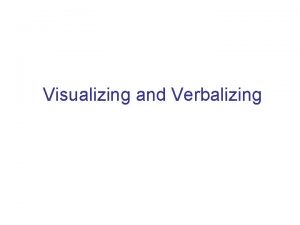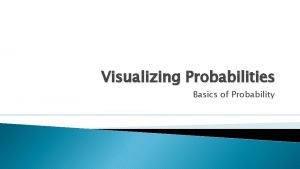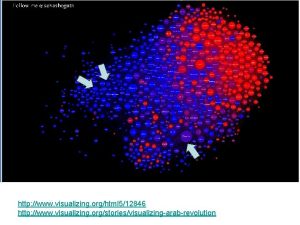Introductory Visualizing Technology Sixth Edition Chapter 10 Security














































- Slides: 46

Introductory Visualizing Technology Sixth Edition Chapter 10 Security and Privacy Copyright © 2018, 2017, 2016 Pearson Education, Inc. All Rights Reserved

Learning Objectives 10. 1 Recognize Different Types of Cybercrime 10. 2 Differentiate between Various Types of Malware 10. 3 Explain How to Secure a Computer 10. 4 Practice Safe Computing 10. 5 Discuss Laws Related to Computer Security and Privacy Copyright © 2018, 2017, 2016 Pearson Education, Inc. All Rights Reserved

Learning Objective 10. 1 Recognize Different Types of Cybercrime Copyright © 2018, 2017, 2016 Pearson Education, Inc. All Rights Reserved

Recognize Different Types of Cybercrime Copyright © 2018, 2017, 2016 Pearson Education, Inc. All Rights Reserved

Cybercrime: They Are Out to Get You – Personal Cybercrime (1 of 2) • Harassment ✓ Cyberbullying: between two minors ✓ Cyber-harassment: between adults ✓ Cyber-stalking: • More serious in nature • Stalker demonstrates a pattern of harassment • Poses a credible threat of harm Copyright © 2018, 2017, 2016 Pearson Education, Inc. All Rights Reserved

Cybercrime: They Are Out to Get You – Personal Cybercrime (2 of 2) • Phishing ✓ Email messages and IMs ✓ Appear to be from someone with whom you do business ✓ Designed to trick you into providing usernames and passwords • Pharming ✓ Redirects you to a phony website even if you type the URL ✓ Hijacks a company’s domain name Copyright © 2018, 2017, 2016 Pearson Education, Inc. All Rights Reserved

Cybercrime: They Are Out to Get You – Social Network Attacks (1 of 4) • Adware and other malware • Suspicious emails and notifications üAppear to be from a site administrator • Asking for your password • Threatening to suspend your account • Phishing and "Please send money" scams Copyright © 2018, 2017, 2016 Pearson Education, Inc. All Rights Reserved

Cybercrime: They Are Out to Get You – Social Network Attacks (2 of 4) • Clickjacking üClicking on a link allows this malware to post unwanted links on your page • Malicious script scams üYou copy and paste some text into your address bar üIt might execute a malicious script § Creates pages and events § Sends spam out to your friends Copyright © 2018, 2017, 2016 Pearson Education, Inc. All Rights Reserved

Cybercrime: They Are Out to Get You – Social Network Attacks (3 of 4) • Fraud üSchemes that convince you to give money or property to a person üShill bidding is fake bidding to drive up the price of an item Copyright © 2018, 2017, 2016 Pearson Education, Inc. All Rights Reserved

Cybercrime: They Are Out to Get You – Social Network Attacks (4 of 4) • Identity theft üThe use of your name, Social Security number, or bank or credit cards for financial gain üKeyloggers • Programs or devices that capture what is typed Copyright © 2018, 2017, 2016 Pearson Education, Inc. All Rights Reserved

Cybercrime: They Are Out to Get You – Cybercrime Against Organizations (1 of 2) • Hacking üWhite-hat or “sneakers” • Attempt to find security holes in a system to prevent future hacking üBlack-hat or “crackers” • Malicious intent üGray-hat • Illegal but not malicious intent Copyright © 2018, 2017, 2016 Pearson Education, Inc. All Rights Reserved

Cybercrime: They Are Out to Get You – Cybercrime Against Organizations (2 of 2) • Hacktivism üHacking to make a political statement • Data breach üSensitive data is stolen or viewed by someone not authorized • Cyber-terrorism Copyright © 2018, 2017, 2016 Pearson Education, Inc. All Rights Reserved

Learning Objective 10. 2 Differentiate between Various Types of Malware Copyright © 2018, 2017, 2016 Pearson Education, Inc. All Rights Reserved

Differentiate between Various Types of Malware Copyright © 2018, 2017, 2016 Pearson Education, Inc. All Rights Reserved

Malware: Pick Your Poison – Spam and Cookies (1 of 3) • Includes different types of programs designed to be harmful or malicious üSpam üAdware and spyware üViruses üWorms üTrojan horses üRootkits Copyright © 2018, 2017, 2016 Pearson Education, Inc. All Rights Reserved

Malware: Pick Your Poison – Spam and Cookies (2 of 3) • Spam ✓ Spamming is sending mass unsolicited emails ✓ Messages are called spam ✓ Other forms: • Fax spam • IM spam • Text spam Copyright © 2018, 2017, 2016 Pearson Education, Inc. All Rights Reserved

Malware: Pick Your Poison – Spam and Cookies (3 of 3) • Cookies ✓ Installed without your permission ✓ Help websites identify you when you return § Track websites and pages you visit to better target ads § May collect information you don’t want to share Copyright © 2018, 2017, 2016 Pearson Education, Inc. All Rights Reserved

Malware: Pick Your Poison – Adware and Spyware (1 of 2) • Adware ✓ Pop-ups or banner ads ✓ Generate income ✓ Use CPU cycles and Internet bandwidth ✓ Reduce PC performance Copyright © 2018, 2017, 2016 Pearson Education, Inc. All Rights Reserved

Malware: Pick Your Poison – Adware and Spyware (2 of 2) • Spyware ✓ Malware ✓ Secretly gathers personal information ✓ Usually installed by accident ✓ Browser hijacker Copyright © 2018, 2017, 2016 Pearson Education, Inc. All Rights Reserved

Malware: Pick Your Poison – Viruses, Worms, Trojans, and Rootkits (1 of 5) • Virus - a program that replicates itself and infects computers üNeeds a host file üMay use an email program to infect other computers üThe attack is called the payload üCheck to see if message is a hoax Copyright © 2018, 2017, 2016 Pearson Education, Inc. All Rights Reserved

Malware: Pick Your Poison – Viruses, Worms, Trojans, and Rootkits (2 of 5) • Logic Bomb ✓ Behaves like a virus ✓ Performs malicious act ✓ Does not replicate ✓ Attacks when certain conditions are met • Time Bomb ✓ A logic bomb with a trigger that is a specific time or date § April Fool’s Day § Friday the 13 th Copyright © 2018, 2017, 2016 Pearson Education, Inc. All Rights Reserved

Malware: Pick Your Poison – Viruses, Worms, Trojans, and Rootkits (3 of 5) • Worms ✓ Self-replicating ✓ Do not need a host to travel ✓ Travel over networks to infect other machines ✓ Conficker worm § First released in 2008 § Reemerged in 2010 with new behaviors Copyright © 2018, 2017, 2016 Pearson Education, Inc. All Rights Reserved

Malware: Pick Your Poison – Viruses, Worms, Trojans, and Rootkits (4 of 5) • Botnet üNetwork of computer zombies or bots controlled by a master üFake security notifications üDenial-of-service attacks • Cripple a server or network by sending out excessive traffic • Trojan horse üAppears to be legitimate program üActually malicious üMight install adware, a toolbar, a keylogger, or open a backdoor Copyright © 2018, 2017, 2016 Pearson Education, Inc. All Rights Reserved

Malware: Pick Your Poison – Viruses, Worms, Trojans, and Rootkits (5 of 5) • Ransomware üMalware that prevents you from using your computer until you pay a fine or fee üBitcoin is an anonymous, digital, encrypted currency • Rootkit üSet of programs üAllows someone to gain control over system üHides the fact that the computer has been compromised üNearly impossible to detect üMasks behavior of other malware Copyright © 2018, 2017, 2016 Pearson Education, Inc. All Rights Reserved

Learning Objective 10. 3 Explain How to Secure a Computer Copyright © 2018, 2017, 2016 Pearson Education, Inc. All Rights Reserved

Explain How to Secure a Computer Copyright © 2018, 2017, 2016 Pearson Education, Inc. All Rights Reserved

Shield’s Up – Software (1 of 2) • Drive-by download üA visited website installs a program in the background without your knowledge • Firewall üHardware device that blocks access to your network üSoftware that blocks access to an individual machine Copyright © 2018, 2017, 2016 Pearson Education, Inc. All Rights Reserved

Shield’s Up – Software (2 of 2) • Antivirus program üProtects against viruses, Trojans, worms, spyware üWindows 10 includes Windows Defender • An antispyware program that performs both real-time protection and system scanning • Antispyware software üPrevents adware and spyware from installing • Security suite üPackage of security software üCombination of features Copyright © 2018, 2017, 2016 Pearson Education, Inc. All Rights Reserved

Shield’s Up – Hardware (1 of 2) • Router üConnects two or more networks together üHome router acts like firewall • Network address translation (NAT) üSecurity feature of a router üShields devices on private network from the public network Copyright © 2018, 2017, 2016 Pearson Education, Inc. All Rights Reserved

Shield’s Up – Hardware (2 of 2) • SSID (Service Set Identifier) üWireless network name • Wireless encryption üAdds security by encrypting transmitted data üWi-Fi Protected Setup (WPS) is one option Copyright © 2018, 2017, 2016 Pearson Education, Inc. All Rights Reserved

Shield’s Up – Operating System • Most important piece of security software • Keep patched and up-to-date Copyright © 2018, 2017, 2016 Pearson Education, Inc. All Rights Reserved

Learning Objective 10. 4 Practice Safe Computing Copyright © 2018, 2017, 2016 Pearson Education, Inc. All Rights Reserved

Practice Safe Computing Copyright © 2018, 2017, 2016 Pearson Education, Inc. All Rights Reserved

An Ounce of Prevention is Worth a Pound of Cure – User Accounts • Three user account types üStandard üAdministrator üGuest • User Account Control (UAC) notifies you prior to changes made to your computer üDo not turn this feature off üAlways read message before clicking Yes • Malware tricks users into clicking fake Windows notifications Copyright © 2018, 2017, 2016 Pearson Education, Inc. All Rights Reserved

An Ounce of Prevention is Worth a Pound of Cure – Passwords Copyright © 2018, 2017, 2016 Pearson Education, Inc. All Rights Reserved

An Ounce of Prevention is Worth a Pound of Cure – Encryption • Converts plain text into ciphertext • Must have a key to decrypt it Copyright © 2018, 2017, 2016 Pearson Education, Inc. All Rights Reserved

An Ounce of Prevention is Worth a Pound of Cure – Safely Installing Software • Copies files to the computer • Alters settings Copyright © 2018, 2017, 2016 Pearson Education, Inc. All Rights Reserved

An Ounce of Prevention is Worth a Pound of Cure – Updating and Installing Software • Protect yourself from downloading problems üOnly download from reliable sources • Zero-day exploit üAttack that occurs on the day an exploit is discovered before the publisher can fix it • Bugs üFlaws in the programming of software üPatch or hotfix üService pack Copyright © 2018, 2017, 2016 Pearson Education, Inc. All Rights Reserved

An Ounce of Prevention is Worth a Pound of Cure – Acceptable Use Policies (AUP) • Common in businesses and schools • Rules for computer and network users • Depend on: ü Type of business ü Type of information • Force users to practice safe computing Copyright © 2018, 2017, 2016 Pearson Education, Inc. All Rights Reserved

Learning Objective 10. 5 Discuss Laws Related to Computer Security and Privacy Copyright © 2018, 2017, 2016 Pearson Education, Inc. All Rights Reserved

Discuss Laws Related to Computer Security and Privacy Copyright © 2018, 2017, 2016 Pearson Education, Inc. All Rights Reserved

The Law is on Your Side – The Enforcers • No single authority responsible for investigating cybercrime • Internet Crime Complaint Center (IC 3) üPlace for victims to report cybercrimes üic 3. gov üReports processed and forwarded to appropriate agency Copyright © 2018, 2017, 2016 Pearson Education, Inc. All Rights Reserved

The Law is on Your Side – Current Laws (1 of 2) • Computer Fraud and Abuse Act üMakes it a crime to access classified information üPassed in 1986; amendments between 1988 and 2002 added additional cybercrimes • USA PATRIOT Act antiterrorism legislation (2001) Copyright © 2018, 2017, 2016 Pearson Education, Inc. All Rights Reserved

The Law is on Your Side – Current Laws (2 of 2) • Cyber Security Enhancement Act (2002) üProvisions for fighting cybercrime • Convention on Cybercrime Treaty üDrafted by Council of Europe üSigned by more than 40 countries Copyright © 2018, 2017, 2016 Pearson Education, Inc. All Rights Reserved

Questions Copyright © 2018, 2017, 2016 Pearson Education, Inc. All Rights Reserved

All rights reserved. No part of this publication may be reproduced, stored in a retrieval system, or transmitted, in any form or by any means, electronic, mechanical, photocopying, recording, or otherwise, without the prior written permission of the publisher. Printed in the United States of America. Copyright © 2018, 2017, 2016 Pearson Education, Inc. All Rights Reserved
 Automotive technology principles diagnosis and service
Automotive technology principles diagnosis and service Automotive technology sixth edition
Automotive technology sixth edition Peter piper tongue twister
Peter piper tongue twister The sixth sick sheik's sixth sheep's sick lyrics
The sixth sick sheik's sixth sheep's sick lyrics Introductory chemistry 4th edition
Introductory chemistry 4th edition Introductory chemistry 5th edition nivaldo j. tro
Introductory chemistry 5th edition nivaldo j. tro Introductory chemistry 5th edition answers
Introductory chemistry 5th edition answers Biochemistry sixth edition
Biochemistry sixth edition Computer architecture a quantitative approach sixth edition
Computer architecture a quantitative approach sixth edition Apa sixth edition
Apa sixth edition Computer architecture a quantitative approach sixth edition
Computer architecture a quantitative approach sixth edition Precalculus sixth edition
Precalculus sixth edition Rational people think at the margin
Rational people think at the margin Computer architecture a quantitative approach sixth edition
Computer architecture a quantitative approach sixth edition Private security
Private security Sixth sense technology seminar report
Sixth sense technology seminar report Sixth sense technology seminar
Sixth sense technology seminar Sixth sense ted
Sixth sense ted Security in computing 5th edition ppt chapter 2
Security in computing 5th edition ppt chapter 2 Using mis (10th edition) 10th edition
Using mis (10th edition) 10th edition Using mis 10th edition
Using mis 10th edition Introductory statistics chapter 2 answers
Introductory statistics chapter 2 answers Modes of speciation ppt
Modes of speciation ppt Failure of supporting utilities and structural collapse
Failure of supporting utilities and structural collapse William stallings network security essentials 5th edition
William stallings network security essentials 5th edition Cryptography and network security 6th edition
Cryptography and network security 6th edition Computer security principles and practice 4th edition
Computer security principles and practice 4th edition Management of information security 5th edition
Management of information security 5th edition Cryptography and network security 6th edition pdf
Cryptography and network security 6th edition pdf Cryptography and network security 4th edition
Cryptography and network security 4th edition Security in computing 5th edition answers
Security in computing 5th edition answers Principles of information system
Principles of information system Information asset classification worksheet
Information asset classification worksheet Computer security fundamentals 4th edition
Computer security fundamentals 4th edition Principles of information security 4th edition
Principles of information security 4th edition Information security
Information security Computer security principles and practice 4th edition
Computer security principles and practice 4th edition Network security essentials 5th edition
Network security essentials 5th edition Cryptography and network security pearson
Cryptography and network security pearson Information technology project management 9th edition
Information technology project management 9th edition Information technology project management 9th edition ppt
Information technology project management 9th edition ppt Ethics in information technology 6th edition answers
Ethics in information technology 6th edition answers Ethics in information technology fourth edition
Ethics in information technology fourth edition Project management quality control
Project management quality control Information technology project management 9th edition
Information technology project management 9th edition Basic environmental technology 6th edition pdf
Basic environmental technology 6th edition pdf Information technology project management 9th edition
Information technology project management 9th edition


















